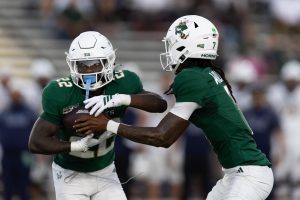Athletics lacking boosters
February 22, 2007
Each Sacramento State student currently pays $52.50 of tuition toward the Hornet athletic department. This student money, totaling more than $2.3 million each, goes to Associated Students, Inc. before being handed over to athletics.
In return, the athletic department’s performance has been disappointing in many areas. The football, men’s basketball and women’s basketball programs combined for a total of 11 wins and 55 losses this past school year.
The Hornet women’s basketball team was the only Division I team to finish the season winless. Sac State’s baseball team was voted out of the Big West Conference by the Big West board of directors who said that the Hornets could only stay in the conference if Sac State’s other athletic programs moved to the Big West.
The Hornets will go independent starting next year.
While a few programs, such as volleyball, women’s tennis and rowing, have faired well, most Hornet programs have struggled to compete.
Meanwhile, at the University of Montana – where there are only 12,000 students to Sac State’s 26,923, students – pay only $30 towards athletics.
In return, Montana students have a football program that won the 2001-2002 Big Sky Conference title and NCAA I-AA National Championship and a men’s basketball team that advanced to the 2002 NCAA tournament.
“The (Sac State) administration needs to look at different ways to get money into the (athletic) program,” said Artemio Pimentel, president of Associated Students, Inc. “I can almost guarantee that Montana does a lot better job of getting out into the community more and raising money through public entities.”
Debby Colberg, who is in her final year serving as Hornet athletic director, admits that the university could be doing a better job of getting money from sources other than Sac State students.
“I think we do a good job of getting money in the marketing area,” Colberg said. “But I don’t feel we do a good enough job in the booster area.”
Pimentel believes he might know the reason for the departments’ lack of money from boosters.
“Athletics may have been less motivated to go out into the community knowing that they had (money from ASI) guaranteed,” Pimentel said.
Sac State currently gets $100,000 from boosters (Hornet fans who contribute money to the athletic department) through the Green and Gold Club.
Hornet athletics get an additional $100,000 from coaches getting donations.
The athletic department also gets $2.8 million from the university’s budget, $316,000 from the NCAA, $250,000 from corporate sponsors, $178,000 through ticket sales and $174,000 from other areas.
This adds up to an athletic department budget of more than $6 million, with approximately 38 percent coming from students.
“I feel that ASI is doing more than their part,” Pimentel said.
Sac State students didn’t always pay the present-day figure of $52.50 toward athletics. In fact, back in 1995, a mere $5 came out of students’ pockets for the department.
In March of 1995, a group of several hundred Hornet athletes gathered in Hornet Gym, rallying for students to pay an increased fee to athletics. The athletes had the backing of then ASI president Stephen Henderson and former athletic director Lee McElroy.
“Somebody’s got to come in and save athletics. If not from the students, where is this money going to come from?” said Henderson in a 1995 State Hornet article titled “Athletics rallies for referendum.”
The rally worked, and in the 1995 election, Sac State students were presented with the option of having their fees to athletics increased by increments of $5 or $10 over the next four years.
The students chose option B, the $10 increment, which has brought student fees toward athletics to the present-day $52.50 figure.
Meanwhile, Hornet athletics have seen no significant improvement in achieving wins or building new facilities, which Colberg feels are vital to a successful athletic department.
“I would like to see the department get new facilities because that is what is going to attract recruits,” Colberg said.
As Hornet athletics continues to struggle, Pimentel, who feels he and ASI’s “hands should not have been tied with (the) rolling contract, ” has to deal with disappointed students.
“The No.1 complaint I get from students is ‘why are we funding athletics when they aren’t doing their job?'” Pimentel said. “Then I have to sit down and explain to them that it’s a referendum and we have to pay it.”
Junior Mike Chrisman doesn’t mind paying the $52.50, he just hopes his money is being spent wisely.
“I would hope the extra money we are paying is going to recruiting and trying to bring in better student athletes,” Chrisman said.
Send comments, questions, or concerns to [email protected].
For questions or information regarding the site,please contact [email protected]


























































































































